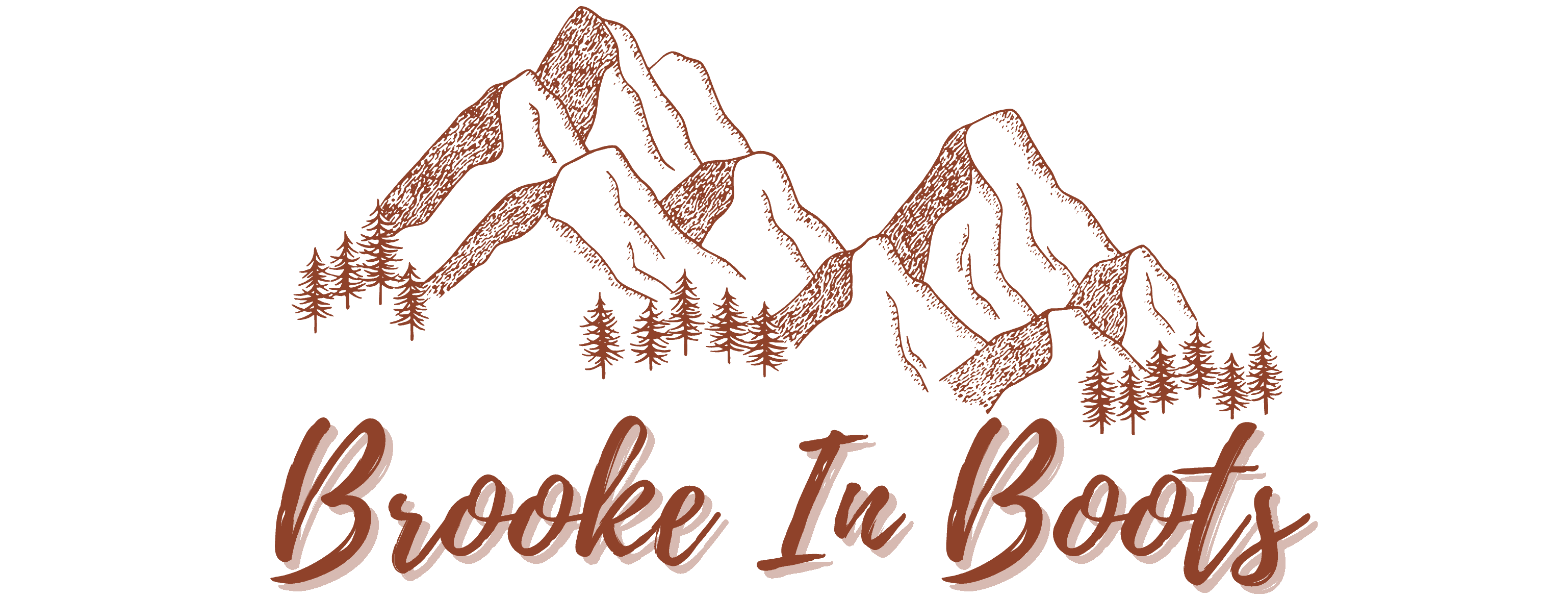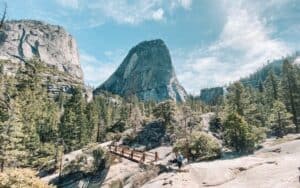
The landscape of Joshua Tree is like nowhere else on this planet . The unmistakeable vibes of this iconic desert are an epic playground for hiking, climbing, and exploring. Spending one day in Joshua Tree is a must for any SoCal visitor – even if you only have time for a short trip!
I’m a little ashamed to say that as a Southern California native, it took me way too long to finally explore this National Park, even though it was basically in my own backyard!
When I finally visited, I was in awe at the spiky Joshua Trees and loved exploring the towers of jumbled boulders just begging to be climbed.
This guide covers the best hikes, scenic drives, and viewpoints you simply can’t miss if you only have one day in Joshua Tree National Park. You’ll explore sunrise at the Cholla Cactus garden, hike to Arch Rock, Heart Rock, and Skull Rock, visit historic sites, explore a hidden world on the Hidden Valley Trail, and stay for an epic sunset over Keys View.
I’ve also included some need-to-know information about getting around the Park, tips for avoiding the crowds, and my favorite spots to eat, drink, and stay near Joshua Tree National Park.
Disclosure: This page may contain affiliate links where I earn a small commission from any purchase – at no extra cost to you. This commission helps keep Brooke In Boots up and running. As always, all opinions are 100% honest and my own!
What to See in Joshua Tree (If You Only Have One Day!)
If you only have 1 day in Joshua Tree National Park, here are my favorite must-see spots I recommend:
1. Sunrise at Cholla Cactus Garden
2. Hike to Arch Rock & Heart Rock
3. Visit Skull Rock & Discovery Trail
4. Take a Hike to Ryan Mountain, Barker Dam, Wall Street Mill, or Lost Horse Mine
5. Lunch in Joshua Tree or Twentynine Palms & Visitor Center
6. Hidden Valley Trail
7. Sunset at Keys View
This guide covers all of these stops in tons of detail, below. I’ve also included important things to to know about planning your day trip to Joshua Tree,
Have more time in Joshua Tree? Check out this Joshua Tree Weekend itinerary blog post.
Planning a trip to Joshua Tree National Park? The downloadable Joshua Tree Itinerary Guide has your perfect 1, 2, or 3 day Joshua Tree trip completely planned for you! With over 20 pages of detailed hiking guides, printable daily itineraries, lodging and dining suggestions and more, you can spend less time planning and more time making epic memories! Check it out, here.

Where is Joshua Tree National Park?
Joshua Tree National Park is in the Mojave Desert of Southern California. The nearest towns to Joshua Tree are Joshua Tree, California and Twentynine Palms, California.
Joshua Tree is located approximately 2 to 3 hours from Los Angeles, 3 hours from Las Vegas, and less than 1 hour form Palm Springs. Its convenient location makes it a popular weekend and day trip destination.
Joshua Tree is also a 4 hour drive to Death Valley National Park, another must-see stop on any California road trip.

Entrance Fees, Passes, and Reservations to Joshua Tree National Park
Reservations are not required to enter Joshua Tree National Park. Learn more about which National parks require entrance reservations.
Joshua Tree National Park charges an entrance fee for all vehicles entering the park, or pedestrian/cyclist pass for all visitors entering without a vehicle:
Vehicle Entrance Fee: $30 (valid for 7 days)
Motorcycle Entrance Fee: $25 (valid for 7 days)
Individual & Cyclist Fee: $15 (valid for 7 days)
One Day in Joshua Tree Tips: During popular times (weekends and cold months) there can be huge wait times at the entrance stations to enter Joshua Tree. Save time by buying your entrance pass ahead of time, here. In my experience, entering at or before sunrise is the best way to avoid crowds and get the most popular trails and spots all to yourself!
Is Joshua Tree Kid Friendly?
Joshua Tree is a wonderful Park to explore with your children! There are many easy to moderate hikes inside the Park, perfect for all ability levels.
Kids will love exploring this real-life Dr. Seuss book come to life! As with all wild places, make sure to carefully supervise children, do not allow them to approach wildlife or the prickly cactus and Joshua Trees.
Supervise children (and adults!) while climbing on rocks and boulders. Be aware that serious injury and death from falls have occurred here.

Is Joshua Tree Dog Friendly?
Yes! Joshua Tree is a relatively dog-friendly National Park (especially in a California National Park, which are usually not pet-friendly).
Leashed pets are permitted within 100 feet of roads, picnic areas, and campgrounds. Pets are NOT permitted on trails, but are permitted on all unpaved dirt roads. These roads are built for off-road driving, but are a popular option for dog walking and are often just as scenic as some of the established hiking trails.
Never ever EVER leave your pet in a vehicle or unattended. Review the Park’s pet policies and tips before visiting with your furry friend!
Services Available in Joshua Tree National Park
There are NO services located inside Joshua Tree National Park. Even half the Park Visitor Centers are located outside the Park. There is no food or gas, and few visitor services inside the park. Potable water may be available at Park campgrounds.
Make sure to plan ahead when visiting Joshua Tree and bring plenty of your own food, water, maps, hiking and camping gear, and firewood. Remember, there is no cell service inside the Park, so you will want to plan ahead!
Cell Service in Joshua Tree National Park
Do not expect to get cell service in Joshua Tree National Park. There is limited-to-no service or data coverage inside the National Park. There is reliable cell service in the towns surrounding Joshua Tree National Park, including Twentynine Palms and Joshua Tree.
Looking for a way to stay connected – even in the wilderness? I always bring my Garmin InReach Mini satellite device when I travel! This little gadget allows me to send and receive texts, share my location, and contact search and rescue, even when there’s zero cell service! I highly recommend investing in one (requires a monthly subscription).
Check Out These Posts for More Free Resources on Visiting Joshua Tree
An Unforgettable Joshua Tree National Park Weekend: 2 & 3 Day Epic Itineraries
Closest Airports to Joshua Tree National Park & How to Get There
The Perfect Joshua Tree One Day Itinerary
Hiking Joshua Tree: 17 Memorable Hikes in Joshua Tree National Park

How Did Joshua Tree Get It’s Name?
The spiny twisting branches of the Park’s namesake Joshua Tree are unlike any other tree on earth. These strange desert plants look like they sprang straight from a Dr. Seuss book. Joshua Trees are actually not a “tree” at all, but a large agave succulent. The Joshua Tree is found in the Mojave Desert, primarily in California and Nevada.
Legend says that the Joshua Tree got its name from the Mormon settlers who arrived in the mid-19th century. The outstretched branches were said to have reminded imaginative immigrants of the biblical figure Joshua, arms raised in faithful supplication and beckoning the Mormons westward.
Once widespread throughout the Southwestern United States, the Joshua Tree’s future is uncertain. Due to climate change, the Joshua Tree may not be able to survive in the Park’s ecosystem by 2100. Due to its threatened status, the Joshua Tree is protected by the California Endangered Species Act. Do not damage, kill, or take any Joshua Trees during your visit!
Joshua Tree National Park as Indigenous Land
Joshua Tree National Park is the ancestral land of the Serrano, the Chemehuevi, and the Cahuilla people. These indigenous people lived, traveled, and cultivated the Mojave Desert for many generations. Artifacts and indigenous art can be found throughout the park. Never disturb, deface, or touch indigenous and historic sites.
Many people of indigenous ancestry continue to live near the Park today, including the Twenty Nine Palms Band of Mission Indians.
Planning Your Joshua Tree Day Trip Itinerary
Because of it’s convenient location between Los Angeles, Palm Springs, and Las Vegas, Joshua Tree National Park is a popular day-trip destination.
Can You See Joshua Tree in a Day?
How much time is needed in Joshua Tree? Although you can spend multiple days exploring this incredible desert landscape, its accessibility and relatively small size means you can see much of Joshua Tree National Park in one day or less! I recommend spending at least 2-3 hours in this Park, but the longer the better!
How long does it take to drive through Joshua Tree? Technically, you can drive through Joshua Tree (West to East or East to West) in under an hour, or North to South (and South to North) in under two hours. But if you don’t get out of the car at least once, I guarantee you’ll regret it!
If you only have 1 day in Joshua Tree National Park, try and arrive as early as possible. Arriving early (before 9 am) means you’ll skip the worst crowds, longest entrance lines, find ample parking, and avoid hiking during the hottest parts of the day. Even in winter, the sun here is relentless, so starting early is crucial.
Can You Do in Joshua Tree in a Half Day?
While you really want to spend a full day (or more) in Joshua Tree, it is possible to have a fantastic experience in Joshua Tree in half a day.
If you are passing by Joshua Tree on your way to LA, Las Vegas, Death Valley or elsewhere, don’t miss an opportunity to spend an hour or two in this Park!
Learn more about making the most out of your short visit to Joshua Tree, and start planning your next National Parks adventure with my FREE Ultimate National Parks Planning Guide!
Joshua Tree One Day Itinerary Map
This map shows your stops on this 1 day in Joshua Tree itinerary.
How to Use This Map: Click the Icons on the map to see more information about each location. Click the star at the top of the map to add the map to your Google Maps account.
The Perfect 1 Day Joshua Tree National Park Itinerary
Before we jump into my favorite things to see in Joshua Tree, a quick word about starting early. If you’re planning a see Joshua Tree in one day, I highly recommend getting to the Park as early as possible, ideally before sunrise!
This is definitely bad news if, like me, you’re “not a morning person” but its especially important for a couple of reasons:
1. The scorching mid-day sun makes early morning and late afternoon the cooler and best time to hike and explore Joshua Tree.
2. Most crowds start arriving to Joshua Tree around 9 AM. And there are CROWDS. On a spring weekend you can expect to wait as long as an hour at the Park Entrance station just to get into the Park! If you only have one day in Joshua Tree, you don’t want to waste it by sitting in line!
3. Sunrise in the desert is stunning, especially at the Cholla Cactus Garden.
Sunrise at Cholla Cactus Garden
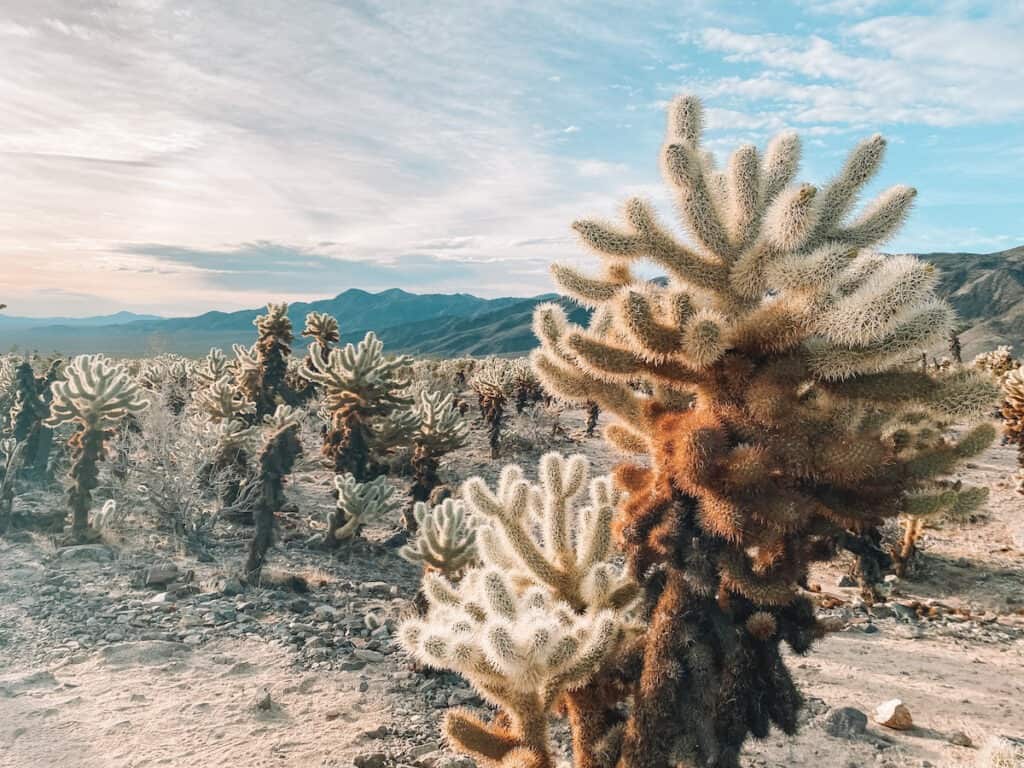
Start your day with a magnificent sunrise at the Cholla Cactus Garden in Joshua Tree. As the rising desert sun creeps over the Eagle Mountains, the Cholla Cactus Garden is illuminated and the spiny cactus appear to “glow” – it’s one of my favorite spots in Joshua Tree for sunrise!
Don’t be confused by the name: the Cholla Cactus Garden is a naturally occurring field of fluffy-looking (but very prickly) Cactus. The Garden is located on Pinto Basin Road, in the eastern park of the Park. A 1/4 mile boardwalk and trail meanders through the cacti and the whole place feels out-of-this-world.
For the best photos, plan to arrive at sunrise and stay about 45 minutes to 1 hour to capture the full experience of the “glowing” cactus. There is a large parking lot directly next to the boardwalk.
Drive carefully through the Park’s winding roads before sunrise – I saw multiple coyotes wandering around the roads on our way to the cactus garden.
Don’t forget to bring a jacket and a hot cup of coffee to warm up – and you’ll definitely want the caffeine for the rest of your itinerary!
Hike to Arch Rock & Heart Rock
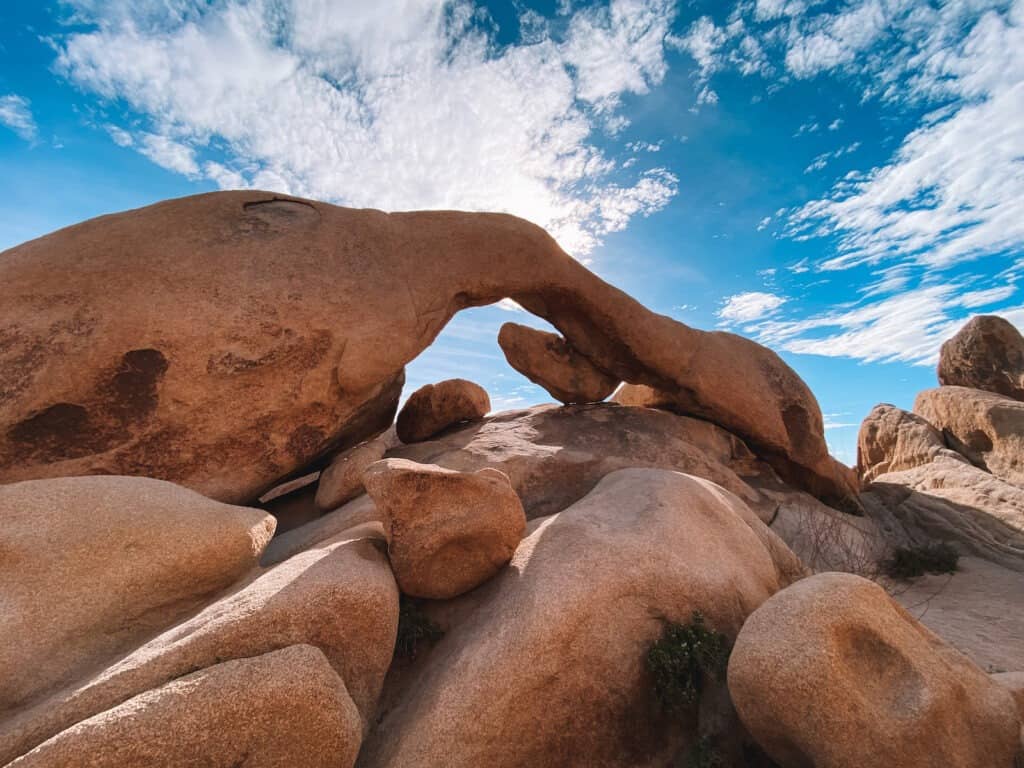
From the Cholla Cactus Garden head back down Pinto Basin Road towards the center of the Park. Park at the Arch Rock Trailhead, a 15 minutes drive from the Cholla Cactus Garden. Here you can explore Arch Rock and Heart Rock along an easy 1.7 Mile Out and Back trail.
The trail winds through a fantastical maze of boulders and Joshua Trees to a massive heart-shaped rock and delicate stone arch, some of the most famous spots in the entire park.
These unique formations were created millions of years ago as liquid magma cooled and formed into granite below the earth’s surface. Over millions of years, water and ice formed the boulders into the shapes you can see today.
Unlike other National Parks, exploring off trail among the boulders is allowed here in Joshua Tree. Spend some time (safely) exploring the labyrinth of stone before returning to the parking lot.
Plan to spend about 1 hour exploring this area before getting back in the car and heading to Skull Rock.
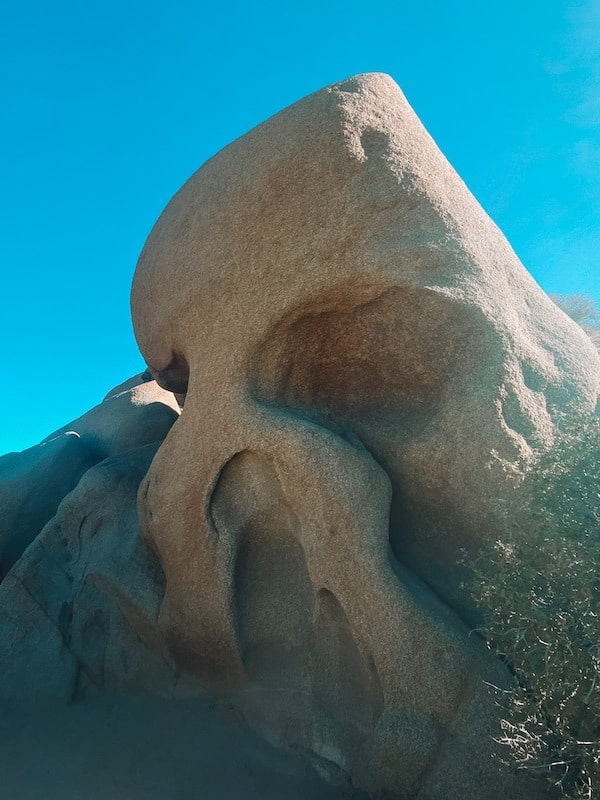
Skull Rock and Discovery Trail
After Heart Rock and Arch Rock, its time to visit another of Joshua Tree’s most famous rock formations: Skull Rock. Continue along Pinto Basin Road towards the center of the Park and make a left onto Park Boulevard. The drive from Arch Rock to Skull Rock takes less than 10 minutes.
Follow signs for Skull Rock and park along Park Boulevard. This unique rock formation is located only a few feet from the main road, making it a very popular spot to visit. There’s no mistaking which rock is “Skull Rock” because, well, the name is pretty much spot-on.
Snap a few quick pics of this spooky spot and head back to the car. If you have time, consider crossing the street to walk the short Discovery Trail
The Discovery Trail is a short 0.7 mile path through boulders and washes. The trail is lined with interpretive signs exploring the geologic forces that shaped Joshua Tree. The Discovery Trail is great for families traveling with kids.
Take a Hike to Ryan Mountain, Barker Dam, Wall Street Mill, or Lost Horse Mine
One of the amazing things about Joshua Tree National Parks is that so much of the Park’s beauty can be seen directly from you car window, or a short walk from the parking lot.
But to really experience the desert (and to get away from the crowds) I suggest slipping on your hiking shoes and hitting some of the Park’s awesome hiking trails!
There are a variety of hikes for everyone here: from moderately challenging hikes up Ryan Mountain, to kid-friendly walks to a historic gold mine.

If you have time in your Joshua Tree day trip itinerary, check out one of these hikes:
| Trail | Difficulty | Distance | Trail Notes |
| Ryan Mountain | Moderate / 1,062′ Gain | 3 Miles (2 Hours) | A relatively short but steep ascent up to prominent Ryan Mountain in the center of the Park. This is one of my FAVORITE hikes in Joshua Tree, and the effort is worth the reward. After climbing steadily uphill with zero shade for what seems like forever, the large summit boasts stunning 360 degree views of Joshua Tree and the surrounding mountains. *There is no shade, so do this hike EARLY (before 9 am). |
| Barker Dam | Easy / 60′ Gain | 1.1 Miles (30 Min) | An easy and kid-friendly loop through the desert ecosystem, past indigenous petroglyph art, out to a historic dam. During rainy season you might see water in the reservoir here. |
| Wall Street Mill | Easy / 75′ Gain | 2 Miles (45 Min) | An easy trek through the boulders and Joshua Trees leads to Wall Street Mill, a gold-processing mill that preserves the Park’s historic (and very colorful) wild west history. Kids and adults will love checking out the abandoned buildings, rusted old cars, and other artifacts along the way. |
| Lost Horse Mine | Moderate / 530′ Gain | 4 Miles (2 Hours) | The trail is mostly flat, with some rocky sections leading to the abandoned Lost Horse Mine, once one of over 300 gold mines located in Joshua Tree. The area’s rich history is filled with gun slingers, cattle rustlers, bandits, and cowboys. The mine is one of the most well preserved mines in any National Park. |
Important Tips for Hiking in Joshua Tree National Park
Hiking is one of the best activities in Joshua Tree National Park. But hiking in the desert takes an extra level of precaution. Follow these hiking tips when planning your Joshua Tree itinerary:
Hike Early: Even in winter, the desert sun in Joshua Tree is relentless! Shade is nonexistent on most hikes, so its best to hike early in the morning. Try and start any long hikes before 9AM.
Bring Plenty of Water: Stay hydrated and bring plenty of water – even on short hikes! A good rule is to carry at least 1 liter of water for every hour of hiking. Drink often, and bring more water than you think you’ll need.
Bring a Map and GPS: Always carry a map or GPS device. DO NOT rely on cell phone service (trust me, you won’t have any out here!) I always bring my Garmin InReach Mini satellite device when I hike! This little gadget allows me to send and receive texts, view & share my location, download and view maps and contact search and rescue, even when there’s zero cell service! I highly recommend investing in one (requires a monthly subscription).
To learn more important hiking safety tips, check out these hiking tips for beginners and learn how to pack for a day hike like a pro!
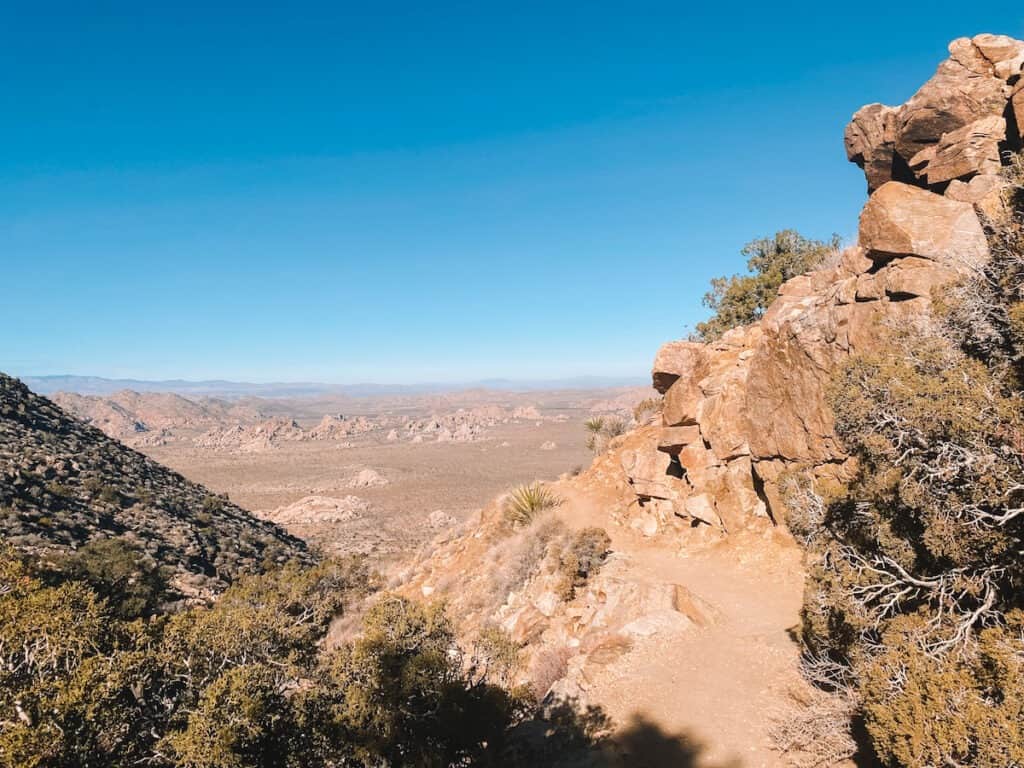
Grab Lunch in Joshua Tree or Twentynine Palms
You’ve definitely worked up an appetite by now, so it’s time to grab lunch! Mid-day is the hottest time in Joshua Tree, and a perfect excuse to head indoors until a little later in the afternoon.
Head into the nearby towns of Joshua Tree or Twentynine Palms and grab lunch at some of the many popular and delicious cafés that cater to hungry hikers. It takes about 30 to 45 minutes to get into town from most places in the Park on this itinerary.
Plan for lunch and stop at the visitor center to take 3 to 4 hours, perfect for beating the mid-day heat.
While waiting for the afternoon sun to ease up, take a walk to some of the many vintage thrift stores, quirky boutiques, and crystal shops that line the main streets of both Joshua Tree and Twentynine Palms. The high-desert Cochella-esque ✨ aesthetic ✨is on full display here – so embrace it!
Be aware: there are no dining options located inside the park. If you packed a picnic, you can head to one of the 8 designated picnic areas in the park, like the Hidden Valley Picnic Area.
Where to Eat Near Joshua Tree National Park
In Joshua Tree I recommend visiting:
Natural Sisters Café: This popular cafe and brunch stop serves wraps, juices, smoothies and other entrees catering to a vegetarian crowd.
Roadrunner Grab & Go: For a to-go sandwich or iced-coffee-pick-me-up it doesn’t get more convenient than Roadrunner, which is actually located inside the Joshua Tree National Park Visitor Center on Park Boulevard. They serve small pasties, premade sandwiches, and cold sides like pasta salad plus a full coffee bar.
Crossroads Cafe: open daily, this popular all-day restaurant serves hearty diner breakfasts until 1:30pm including the staple of any Californian’s diet: the breakfast burrito. For lunch and dinner, pick from their sizable selection of sandwiches, tacos, and salads.
In Twentynine Palms I love:
Grnd Sqrl : Opens at 11am. Meat-eaters need to get the burger, and the rest of their food is pretty dang good too. In addition to a great beer selection, they often have live music in the evenings.
Kitchen in the Desert: Inspired by head chef Everton Gordon’s Caribbean roots, Kitchen in the Desert is one of the best restaurants near Joshua Tree National Park. A mix of New American and Caribbean inspired dishes, the food here is elevated, but the vibes are still fun and casual. Reservations are recommended for this spot.
Campbell Bakery: open for breakfast and lunch, you can identify this tiny but extremely popular bakery by the line that usually wraps around the block. Absolutely everything in here is delightful. Stock up on pastries for breakfast and grab a sandwich for lunch.
Stop by the National Park Visitor Center
With a full stomach (and empty wallet from shopping) I recommend heading to the Joshua Tree Visitor Center, the best Joshua Tree Visitor Center.
It’s located on Park Boulevard in the town of Joshua Tree. There is a bookstore, water, toilets, and a great cafe and coffee shop at this Visitor Center, located a few minutes from the main Park entrance.
Here you can collect your National Park Passport Stamp , learn a bit about the park, refill your water bottle and hit the gift shop,
If you’re headed instead into the town of Twentynine Palms, the National Park Visitor Center (Joshua Tree East Visitor Center) is located in downtown on Highway 62/Twentynine Palms Highway. There are toilets, water, EV charging, and a bookstore at this brand new location. (Note: The Visitor Center is NO LONGER located at the Oasis of Mara on National Park Drive.)
Hidden Valley Nature Trail
After refueling and souvenir shopping in town, head back into the Park to your last hike of the day, and one of my favorites, Hidden Valley Nature Trail.

This 1 mile easy loop trail circles a small valley that hides a unique desert ecosystem, and colorful history. Legend has it that 1800’s cattle rustlers and bandits used the natural protection of the valley to hide their stolen herds.
Today, the Hidden Valley Trail is dotted with interpretive signs explaining about the Valley’s unique ecosystem. The rocks that ring the valley block wind and trap moisture, creating a microclimate. The Valley is home to Piñon pine, juniper, yucca, Joshua Trees, and other desert plants.
Despite being one of the most popular hikes in the Park, the turn-off for Hidden Valley Trail can be a little hard to find. From Park Boulevard, follow signs for the Hidden Valley Picnic Area. The trailhead starts at the restrooms on the right hand side of the parking area.
It takes about 30 minutes to reach Hidden Valley from the Joshua Tree or Twentynine Palms Visitor Centers.
Sunset at Keys View
After a long day exploring Joshua Tree National Park, cap off your adventure by watching sunset over the desert at Keys View. This viewpoint is known for its 360 degree views of Joshua Tree and the surrounding desert.
Keys View is a popular spot for both sunrise and sunset in Joshua Tree. Plan to arrive a bit before sunset to secure a parking spot. The road to Keys Viewpoint may close periodically when parking is full. The good news, is that sunset in Joshua Tree is stunning from pretty much anywhere. There are plenty of spots to pull over along the main road, Park Boulevard.
No matter where you are, find a picturesque spot and enjoy the colorful display of pinks, oranges and blues of the desert sun sets on your perfect Joshua Tree National Park one day itinerary.

How to Spend a Half Day in Joshua Tree
Even if you only have an hour or two you can still visit some of the best must-see sights in Joshua Tree National Park. If you have 3 hours in Joshua Tree National Park or less, use the itinerary below to make the most out of your visit.
If your time is limited and you only have a few hours (or less) in Joshua Tree, I recommend you head straight to Hidden Valley or Arch Rock & Heart Rock. Both of these hike are easy, family friendly, have tons of classic “Joshua Tree vibes”, and take less than an hour to complete.
Of the two spots, Hidden Valley is closer to the Joshua Tree Park Entrance, and more conveniently located to Palm Springs, and major highways, including Interstate 10 and Highway 247.
Learn more about getting to Joshua Tree National Park and Park Entrances further below.
If You Have More than One Day in Joshua Tree
Check out more things to do in this 2 & 3 day Joshua Tree weekend itinerary: The Perfect Joshua Tree National Park Weekend
If you can, plan to spend at least 2 to 3 days exploring Joshua Tree National Park. From rock climbing, 4×4 off-road driving, to backpacking, there are dozens of unique adventures to be had at this California National Park.
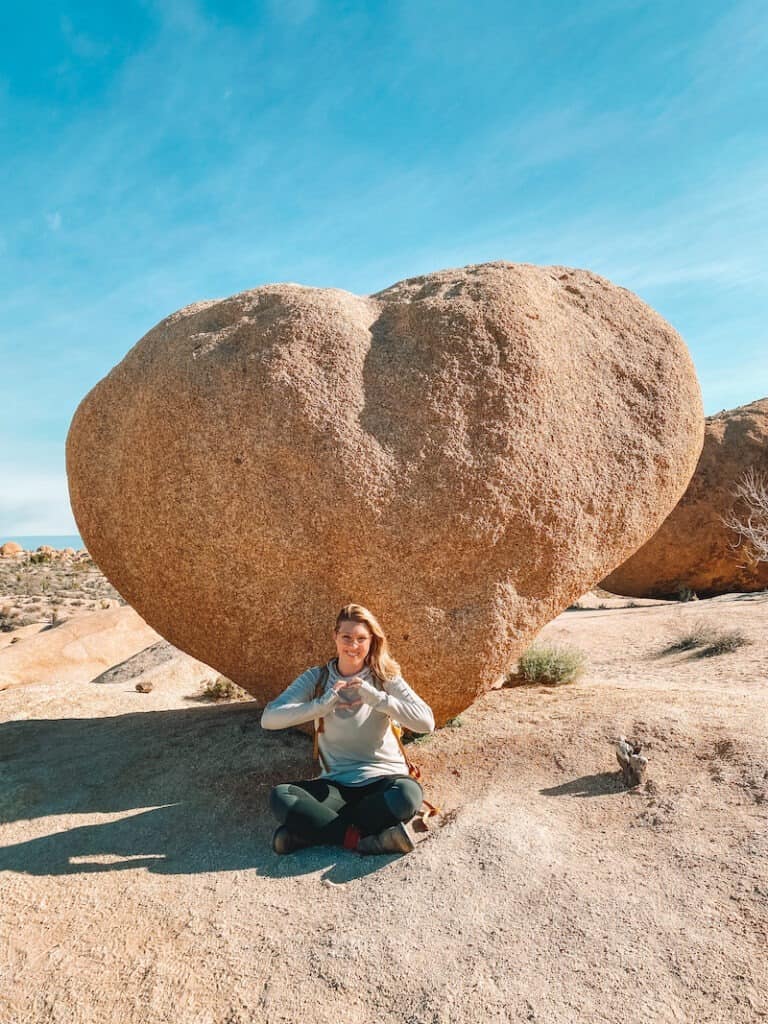
If you have longer than one day to visit, consider adding these to your Joshua Tree National Park itinerary:
Keys Ranch Guided Tour
Cowboys, miners, con artists, pioneers, and murder – the history of Joshua Tree is the history of the Wild West! Learn the story of the Keys Family, one of the Mojave Desert’s most famous founding families on this guided tour of Keys Ranch. Built by William Keys starting in 1910, the Keys Ranch is a large homestead in Joshua Tree preserved by the National Park Service. You can only access the Ranch through an official guided tour. The tour costs $10, takes about 90 minutes and reservations are required. Learn more and book your Keys Ranch Tour here.
More Hikes in Joshua Tree
Joshua Tree has dozens of incredible trails, from family-friendly walks to multi-day backpacking trails. Check out some of these favorite hikes below, or read my full guide to Hiking Joshua Tree: 17 Memorable Hikes in Joshua Tree National Park.
For a longer hike into Joshua Tree’s backcountry, check out part or all of the moderately difficult 16 mile Boy Scout Trail. For the first couple of miles, the flat trail snakes through Joshua Trees and eventually climbs into a rocky area known as the “Wonderland of Rocks” before ending at the Indian Cove campground at the far north end of the Park.
The Boy Scout Trail is a super popular backpacking area, and I highly recommend staying the night out there, especially for beginning backpackers. (But don’t underestimate the winter cold out there – read more about my failed attempt at backpacking the Boy Scout Trail here!)
If you want to hike the Boy Scout Trail as a day hike, consider hiking a few miles out to the Wonderland of Rocks before returning to the trailhead. Or if you have 2 cars, park 1 at the Indian Cove Campground and hike 8 miles one way.
Another great day hike option in Joshua Tree is the Queen Desert Mine Trail (3.4 Miles / Moderate / 650′ Gain). The Queen Desert Mine trail winds through several gold mines and mining homesteads that once dotted the landscape. Take care around historic mining equipment and never attempt to enter an abandoned mine.
Unlike other hikes, this trail is accessed from the Queen Desert Mine Road, a dirt track popular with 4×4 backcountry drivers, but generally accessible to most sedans with 2-wheel-drive. Avoid this road during and after intense rainstorms.
Rock Climbing
One look at the boulders of Joshua Tree and you’ll understand why this Park is one of the most popular rock climbing areas in the West! Rock climbing and bouldering are extremely popular activities in the Park. On any given day you’ll often spot climbers around many rock formations.
Advanced and intermediate climbers can take advantage of the over 8,000 routes established within the park. But beginners can get in on the fun too!
Planning a trip to Joshua Tree National Park? Take this itinerary to-go! The downloadable Joshua Tree Itinerary Guide has your perfect 1, 2, or 3 day Joshua Tree trip completely planned for you! With over 20 pages of detailed hiking guides, printable daily itineraries, lodging and dining suggestions and more, you can spend less time planning and more time making epic memories! Check it out, here.

The Best Time to Visit Joshua Tree National Park
The best time to visit Joshua Tree National Park is November to May.
During the winter and spring, temperatures are warm, even chilly, and the Park occasionally sees snow at higher elevations!
The most popular times to visit Joshua Tree are March and April, when the weather is warm, sunny, and mild.
In my experience, you do NOT want to be visiting Joshua Tree during the summer!
During summer, temperatures routinely hit triple digits throughout the Park. In July 2021, the temps reached a record-breaking 119℉ in nearby Twentynine Palms. Yikes.
The absolute lack of shade plus heat make sunburn, heat exhaustion, and dehydration real dangers during this time of year.
Keep in mind that Joshua Tree covers a huge range of elevations. The lowest elevation in the Park is at 536 feet, and soars to mountain summits over 5,000 feet. Temperatures can vary widely within the Park, and campers and nighttime visitors should be prepared for very cold conditions. Expect temperatures at the higher elevations to be at least 10 degrees cooler than posted conditions.
Check current conditions and forecasts for weather in Joshua Tree National park, here.

How to Get to Joshua Tree National Park
Joshua Tree National Park’s is conveniently located between Los Angeles and Las Vegas. The Park is accessible from several major Interstate Highways.
If you only have one day in Joshua Tree, it helps to stay as close to the Park as possible. The towns of Twentynine Palms orJoshua Tee are the nearest to the Park, although a day trip from Los Angeles is definitely possible!
Joshua Tree also makes a great day trip from the nearby vacation destination of Palm Springs, California.

Nearest Airports to Joshua Tree National Park
Joshua Tree National Park is conveniently located near several major airports. Don’t forget to rent a car and be prepared to drive to the Park. There are no public transportation options in Joshua Tree!
This chart show a quick rundown of the closest airports to Joshua Tree.
| Airport | Distance |
|---|---|
| Palm Springs International Airport | 1 Hour / 43 Miles |
| Ontario International Airport | 2 Hours / 112 Miles |
| Los Angeles International Airport | 3 Hours / 143 Miles |
| Las Vegas International Airport | 3 Hours 15 Minutes / 194 Miles |

Getting Around Joshua Tree National Park
If you are planning a Joshua Tree itinerary, you will need your own vehicle. There are no shuttles or public transportation options to Joshua Tree National Park.
The major roads in and around Joshua Tree are paved and well maintained. Most visitors to Joshua Tree will be perfectly fine in a 2-wheel-drive sedan.
Most major trailheads and all the stops on this itinerary have a small parking lot. If parking is full, (which it usually is after 9AM in Spring) you can usually park on the side of the road a short distance away. Be sure to obey all posted traffic signs, and arrive early to avoid the crowds!
If you want to explore some of Joshua Tree’s many off-road driving trails, make sure you are driving an off-road capable vehicle. Learn more about driving on Joshua Tree’s backcountry roads, here. A four-wheel or high-clearance vehicle is not required for any stops on this itinerary.
Check out this guide for more tips for planning a National Parks road trip – including important safety tips and suggestions for rental cars.
Map of Joshua Tree Entrances & Visitor Centers
There are 3 main entrances to Joshua Tree National Park. The two most commonly used entrances, the North Entrance and West Entrance are on the north side of the Park, near the towns of Joshua Tree and Twentynine Palms.
The South Entrance (or Cottonwood Springs entrance) is located at the southern end of the Park, and is the most convenient entrance for visitors traveling along Interstate 10 and visitors staying at the Cottonwood Springs campground.
The main Joshua Tree visitor center is located in the town of Joshua Tree, just off Park Boulevard. There are no Visitor Centers or Visitor Services inside Joshua Tree National Park.
You can use this map below to find your nearest entrance and Visitor Center. `

Where to Stay in Joshua Tree National Park
Whether you prefer camping, trendy AirBnBs, or chain hotels, there are plenty of options for where to stay before and after your 1 day in Joshua Tree National Park. Most of your options are located in the nearby towns of Twentynine Palms, Joshua Tree, and Yucca Valley.
If you only have a day in Joshua Tree, you’ll absolutely want to stay as close to the Park as possible. But if you’re looking to save a little cash, the further you are from a Park entrance, the generally cheaper the hotels and rentals.
Camping in Joshua Tree National Park
There are no lodges or hotels inside Joshua Tree National park, but there are eight campgrounds, and camping is a very popular activity here.

Reservations are required at Black Rock, Cottonwood, Indian Cove, Jumbo Rocks, and Ryan campgrounds. Reservations can be made up to 6 months in advance on Recreation.gov. Reservations sell out during peak seasons November – May, so make sure too book in advance – especially for weekends in Joshua Tree!
If you want the best views and most convenient location for your one day in Joshua Tree itinerary, the Jumbo Rocks campground is my pick for the best campground.
Don’t have a reservation? Hidden Valley, Belle, and White Tank campgrounds are first-come-first-served. These spots are highly competitive, so arrive early in the day, and early in the week if you want to score a spot during the weekend in Joshua Tree.
Hotels and Rentals Near Joshua Tree
There are plenty of chain hotels near Joshua Tree National Park, mostly in Twentynine Palms and Yucca Valley.
Most of these spots are in the 2-to-3 star range and cost between $100 – $250 per night. Nearby hotels include: Holiday Inn Express Twentynine Palms (from $150; book on Expedia) (I stayed here when it was too cold for backpacking in December); Motel 6 in Twentynine Palms (from $70; book on Expedia); and SureStay by Best Western Yucca Valley (from $150; book on Expedia).
If you want more of a luxury hotel experience, I strongly suggest heading to Palm Springs, about 45 minutes from the Park.
If you’re looking for a place to stay beyond the basic chain hotel, I recommend staying in one of the may AirBnBs and vacation rentals found throughout the Joshua Tree area. These places range from essentially glamping to all-out luxury pads.
In Joshua Tree and Twentynine Palms, check out:
- Relax and watch the stars from the backyard of the Village House (from $190; book on VRBO). The groovy vibes match the 1960s bungalow and include a hot tub, outdoor fire pit, and cold plunge pool.
- The Dome on the Range includes a hot tub, sunken fire pit for nights spent stargazing, and climate-controlled geodesic dome in the yard for relaxing with friends. (from $300; book on VRBO)
- For a dog-friendly chic spot in Twentynine Palms, we stayed at Desert Blush by The Joshua Tree Cabin (from $144 book on AirBnb) and had the loveliest stay.

Backpacking and Wilderness Permits
Beginning March 1, 2023 Joshua Tree National Park will require wilderness permits for all overnight wilderness camping and backpacking within the park.
Dispersed camping is permitted in designated wilderness zones. Camping must be 1 mile from any Backcountry Trailhead, 1/2 mile from a road, and 200 feet off a trail.
Backpackers along the Boy Scout Trail must camp in one of 14 designated campsites.
Permits are released 6 months in advance and are required year-round. Same-day permits are available online up to 2PM through recreation.gov , and in-person until 4pm at the Permit Office. The Permit Office is located at 74485 National Park Blvd, Twentynine Palms, CA, 92277, Bldg. 100.
Reserve Joshua Tree Wilderness Permits here.
Planning a trip to Joshua Tree National Park? The downloadable Joshua Tree Itinerary Guide has your perfect 1, 2, or 3 day Joshua Tree trip completely planned for you! With over 20 pages of detailed hiking guides, printable daily itineraries, lodging and dining suggestions and more, you can spend less time planning and more time making epic memories! Check it out, here.

Explore More California National Parks
Death Valley: How To Spend 2 – 3 Epic Days In Death Valley National Park
Joshua Tree: An Unforgettable Joshua Tree National Park Weekend: 2 & 3 Day Epic Itineraries
Yosemite: Epic 3 Day Yosemite Itinerary: Ultimate Weekend Guide
